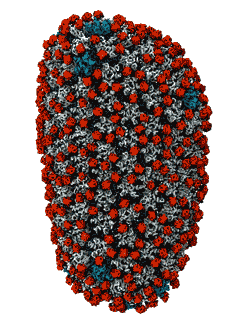Highlights of our Work
2025 | 2024 | 2023 | 2022 | 2021 | 2020 | 2019 | 2018 | 2017 | 2016 | 2015 | 2014 | 2013 | 2012 | 2011 | 2010 | 2009 | 2008 | 2007 | 2006 | 2005 | 2004 | 2003 | 2002 | 2001

image size:
101.5KB
made with VMD
When experimental-computational biologists embarked on the great
challenge of resolving the atomic level structure of the HIV virus
capsid that contains the virus' deadly genetic cargo, they were
advised by referees not to try as the capsid is too big, too
irregular, and nobody would need the highly resolved structural
information. Stubbornly, the researchers went ahead anyway and
succeeded getting the atomic resolution structure, overcoming size and
irregularity challenges (see highlight Elusive
HIV-1 Capsid). But the question remained: Is the atomic level
structure of the huge HIV capsid made of 1,300 proteins useless? The
HIV capsid is a closed container made of protein pentamers and
hexamers, with a surface of continuously changing curvature. Two
recent experimental-computational studies demonstrate now that the
capsid structure is far from useless, in fact, it is a great
treasure. The first
study was published last year and showed that the human protein,
Cyclophilin-A (CypA), involved in several diseases, interacts with the
HIV capsid and affects the capsid's dynamic properties (see highlight
HIV,
Cells and Deception). In a second, recent
study, guided by cryo-EM measurements and benefiting from
large-scale molecular dynamics simulations with NAMD, researchers
could resolve with new accuracy the binding of hundreds of CypA
proteins on the capsid's surface. They found that CypA binds along
high curvature lines of the capsid, which enhances stiffness and
stability of the capsid, even though only about half of the capsid is
actually covered by CypA. The limited levels of CypA stabilize and
protect the viral capsid as it moves through the infected cell towards
the cell's nuclear pore where nuclear proteins additionally bind to
the capsid at places not covered by CypA and promote there uncoating
and release of the capsid cargo into the nucleus. More information is
available on our retrovirus website and in
a news
release.



